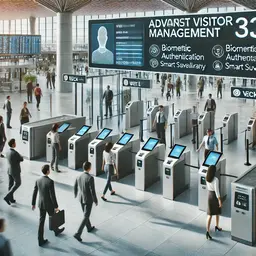
The transportation industry is a vital backbone of global infrastructure, connecting people and goods across vast distances. With millions of travelers, contractors, and employees moving through airports, train stations, ports, and logistics hubs daily, security and efficiency are paramount. A modern visitor management system (VMS) is no longer optional—it is essential for enhancing safety, streamlining operations, and ensuring regulatory compliance.
k
k
The Role of Visitor Management in Transportation Security
Transportation facilities face unique security challenges due to the high volume of daily visitors. Traditional manual check-in processes are not only inefficient but also leave security vulnerabilities. Implementing an automated visitor management system provides real-time oversight of all visitors, ensuring only authorized individuals access restricted areas.
Key Benefits of a Visitor Management System in Transportation
1. Strengthening Security and Access Control
Transportation hubs are high-risk targets for unauthorized access and security threats. A visitor management system helps verify, track, and control who enters a facility, reducing risks related to:
- Unauthorized access to restricted zones
- Potential security breaches from unverified visitors
- Vandalism and other safety concerns
With biometric authentication, digital check-ins, and real-time tracking, visitor management enhances situational awareness and ensures compliance with security mandates.
2. Improving Operational Efficiency
Manual visitor logs and inefficient check-in processes cause delays and congestion in transportation facilities. A cloud-based visitor management system automates:
- Self-service check-ins with QR codes or mobile credentials
- Pre-registration for frequent visitors, vendors, and employees
- Automated access approvals based on visitor credentials
These features accelerate entry times, reduce staffing needs, and eliminate paperwork, allowing transportation hubs to focus on operational efficiency.
3. Compliance with Regulatory Requirements
Transportation hubs must comply with stringent security and safety regulations, including:
- The Transportation Security Administration (TSA) regulations
- International Civil Aviation Organization (ICAO) security standards
- Maritime Transportation Security Act (MTSA)
A visitor management system ensures secure, auditable records of all visitor activity, helping organizations meet compliance standards while reducing liability.
4. Emergency Preparedness and Evacuation Management
In the event of security threats, natural disasters, or health emergencies, transportation hubs must quickly account for all visitors, staff, and contractors. A real-time visitor log allows:
- Instant headcounts during evacuations
- Automated alerts to security teams
- Faster emergency response coordination
By integrating with access control systems, alarm systems, and emergency communication networks, a visitor management system enhances incident response protocols for safer operations.
5. Efficient Contractor and Vendor Oversight
Transportation facilities rely on third-party contractors for maintenance, logistics, and operations. Managing multiple vendors across different zones can be challenging. A visitor management system allows:
- Controlled access for contractors based on job roles
- Time-tracking for labor compliance
- Automated approvals for authorized personnel
This streamlined approach improves workforce accountability and reduces security risks associated with external vendors.
k
k
Essential Features of a Modern Visitor Management System
To meet the demands of the transportation industry, a visitor management system must include advanced technology, such as:
- Digital and self-service check-ins to reduce congestion
- Access control integration to restrict entry to unauthorized individuals
- Biometric and facial recognition for secure authentication
- Cloud-based monitoring for remote oversight of multiple locations
- Real-time alerts and incident reporting for faster response times
- Automated reporting and compliance logs for audit-ready security records
k
k
The Future of Visitor Management in Transportation
With the rise of digital transformation, visitor management systems are evolving to enhance security, convenience, and data intelligence. Future trends include:
- AI-powered threat detection to identify potential security risks before they escalate
- Mobile access credentials to replace physical badges with smartphone-based entry
- Cloud-based access control for remote security management and real-time monitoring
- Biometric authentication for an additional layer of security
- Integration with Internet of Things (IoT) for smart facility management
- Predictive analytics to enhance visitor flow management and risk assessments
By adopting smart visitor management solutions, transportation hubs can future-proof their security infrastructure while ensuring operational continuity and passenger safety.
k
k
Conclusion: A Secure, Efficient Future for Transportation
As passenger volumes grow and security risks evolve, the transportation industry must invest in advanced visitor management solutions. From securing restricted areas to streamlining entry processes, a modern visitor management system safeguards personnel, passengers, and infrastructure while maintaining compliance and operational efficiency.
Is your transportation facility equipped with the right visitor management system? Contact SSP today to explore customized security solutions for your transportation network.


